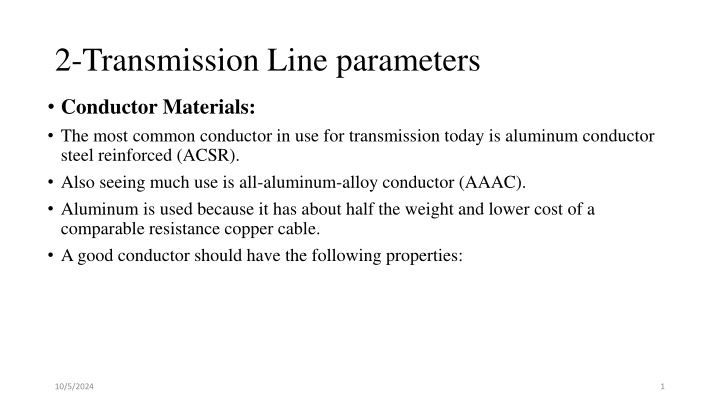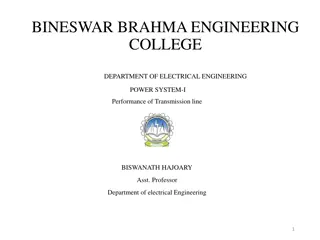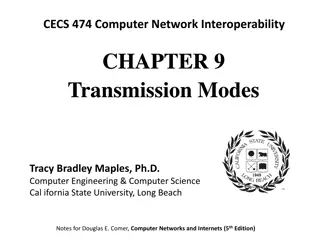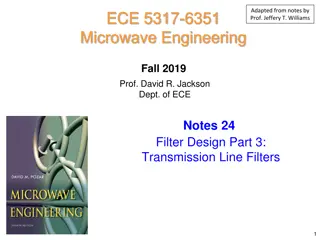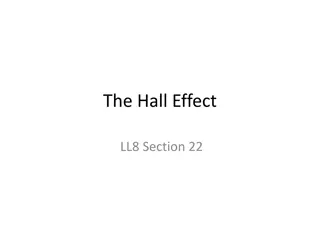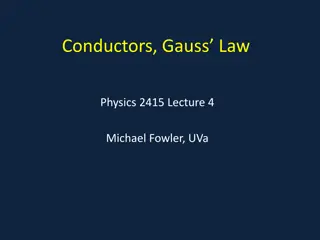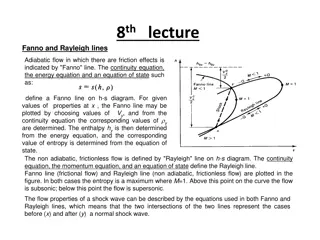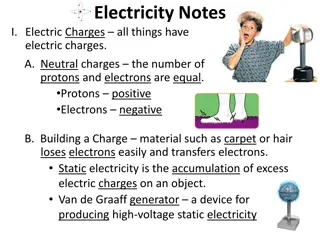Types of Conductors in Transmission Lines
Aluminum conductors, such as AAC, AAAC, ACSR, and ACAR, are commonly used in transmission lines due to their high conductivity, tensile strength, light weight, and resistance to corrosion. AAC is known for its good conductivity but limited strength, while AAAC offers better mechanical strength and corrosion resistance. ACSR features a steel core for additional support. These conductor types have replaced copper conductors in overhead power lines due to their cost-effectiveness and efficiency.
Download Presentation

Please find below an Image/Link to download the presentation.
The content on the website is provided AS IS for your information and personal use only. It may not be sold, licensed, or shared on other websites without obtaining consent from the author.If you encounter any issues during the download, it is possible that the publisher has removed the file from their server.
You are allowed to download the files provided on this website for personal or commercial use, subject to the condition that they are used lawfully. All files are the property of their respective owners.
The content on the website is provided AS IS for your information and personal use only. It may not be sold, licensed, or shared on other websites without obtaining consent from the author.
E N D
Presentation Transcript
2-Transmission Line parameters Conductor Materials: The most common conductor in use for transmission today is aluminum conductor steel reinforced (ACSR). Also seeing much use is all-aluminum-alloy conductor (AAAC). Aluminum is used because it has about half the weight and lower cost of a comparable resistance copper cable. A good conductor should have the following properties: 10/5/2024 1
Required Properties in Materials Used for Conductor in Transmission Line 1.High conductivity 2.High tensile strength 3.Light weight 4.High resistance to corrosion in whether conditions 5.High thermal stability 6.Low coefficient of thermal expansion 7.Low cost 10/5/2024 2
Types Of Conductors aluminum conductors have an edge over copper conductors considering combined factors of- cost, conductivity, tensile strength, weight etc. Aluminium conductors have completely replaced copper conductors in overhead power lines because of their lower cost and lower weight. Though an aluminium conductor has larger diameter than that of a copper conductor of same resistance. Corona reduces considerably with increase in the conductor diameter. 10/5/2024 3
Types Of Conductors AAC : All Aluminium Conductor AAAC : All Aluminium Alloy Conductor ACSR : Aluminium Conductor, Steel Reinforced ACAR : Aluminium Conductor, Alloy Reinforced 10/5/2024 4
AAC : All Aluminium Conductor This type is sometimes also referred as ASC (Aluminium Stranded Conductor). It is made up of strands of EC grade or Electrical Conductor grade aluminium. AAC conductor has conductivity about 61% IACS (International Annealed Copper Standard). Despite having a good conductivity, because of its relatively poor strength, AAC has limited use in transmission and rural distribution lines. AAC can be seen in urban areas for distribution where spans are usually short but higher conductivity is required. 10/5/2024 5
AAAC : All Aluminium Alloy Conductor These conductors are made from aluminium alloy 6201 which is a high strength Aluminium-Magnesium-Silicon alloy. This alloy conductor offers good electrical conductivity (about 52.5% IACS) with better mechanical strength. Because of AAAC's lighter weight as compared to ACSR of equal strength and current capacity, AAAC may be used for distribution purposes. AAAC conductors can be employed in coastal areas because of their excellent corrosion resistance. 10/5/2024 6
ACSR : Aluminium Conductor, Steel Reinforced ACSR consists of a solid or stranded steel core with one or more layers of high purity aluminium (aluminium 1350) wires wrapped in spiral. The core wires may be zinc coated (galvanized) steel or aluminium coated (aluminized) steel. Galvanization or aluminization coatings are thin and are applied to protect the steel from corrosion. The central steel core provides additional mechanical strength and, hence, sag is significantly less than all other aluminium conductors. ACSR conductors are available in a wide range of steel content - from 6% to 40%. ACSR with higher steel content is selected where higher mechanical strength is required, such as river crossing. ASCR conductors are very widely used for all transmission and distribution purposes. 10/5/2024 7
Aluminium Conductor, Alloy Reinforced ACAR conductor is formed by wrapping strands of high purity aluminium (aluminium 1350) on high strength Aluminum Magnesium- Silicon alloy (6201 aluminium alloy) core. ACAR has better electrical as well as mechanical properties than equivalent ACSR conductors. ACAR conductors may be used in overhead transmission as well as distribution lines. 10/5/2024 8
Bundled Conductors Transmission at extra high voltages (say above 220 kV) poses some problems such as significant corona loss and excessive interference with nearby communication lines when only one conductor per phase is used. This is because, at EHV level, the electric field gradient at the surface of a single conductor is high enough to ionize the surrounding air which causes corona loss and interference problems. The electric field gradient can be reduced significantly by employing two or more conductors per phase in close proximity. Two or more conductors per phase are connected at intervals by spacers and are called as bundled conductors. The image at right shows two conductors in bundled form per phase. Number of conductors in a bundled conductor is greater for higher voltages. 10/5/2024 9
Bundled conductor The conductors of any one bundle are in parallel and charge per bundle is assumed to divide equally between the conductors of bundle. The composite or stranded conductors touch each other while the bundled conductors are away from each other. The typical distance is about 30 cm and more. The conductors of each phase are connected by using connecting wires at particular length. 1. Low radio interference and corona loss. 2. Reduced voltage gradient at conductor surface. 3. Increase in capacitance. 4. Low reactance due to increase in self GMD. 5. Increase in surge impedance loading. 10/5/2024 10
Stranded Conductor The stranded conductor usually has a central wire which is surrounded by the layers of wires. These layers consists of 6, 12, 18, ......... wires successively. Thus the total strands are 7, 13, 19 .............. . 10/5/2024 11
Composite Conductor A composite conductor consists of two or more strands of different metals, such as aluminum and steel, or copper and steel (i.e., ACSR, ACAR, AWAC). A conductor consisting throughout its length of two or more metal conductors providing parallel paths sharing the load. 10/5/2024 12
Current Distortion Effect If the transmission lines conductor carries steady current (D.C), the current is distributed uniformly throughout the conductor and if the same conductor carries an alternating current then the current distribution in the conductor is distorted due to the following effects, namely: 1. Skin Effect 2. Proximity effect 3. Spirality Effect 4. Kelvin s Law 10/5/2024 13
Skin Effect The crowding of alternating current on the surface of a conductor is know as Skin Effect . Due to skin effect, the effective area of cross-section of the conductor through which current flow is reduced. Consequently, the resistance of the conductor is slightly increased when carrying an alternating current. 10/5/2024 14
Skin Effect The skin Effect depends, upon the following factors, namely (i) Nature of the material (ii) Diameter of wire: It increases with diameter of wire. (iii) Frequency: Increase with the increase in frequency. (iv) Shape of wire: Less for stranded conductor that the solid conductor. Skin effect increase with the increase in frequency, conductor diameter and permeability. 10/5/2024 15
2. Proximity Effect: if the field due to return conductor is considered then this effect is called proximity Effect . Due to this effect the current will be concentrated/crowded on one half side of conductor. This effect is more increase of large conductors and at high frequencies. This effect is disappeared in case of stranded conductor because the conductors are spiraled. 10/5/2024 16
3. Spirality effect: This effect is mainly depends on size and method of construction of the conductor. Due to spirality effect it increases both resistance and internal reactance of a standed conductor. 4. Kelvin s Law: Economic size of the Transimission line conductor [Kelvin s Law] The size of conductor plays a vital role in total cost of the transmission line. Hence, it is very necessary to determine most economical size of the conductor in the transmission lines. In 1881, Lord Kelvin stated that the most economical are of the conductor is that for which the total annual cost of transmission line is minimum. Hence, this law is named as Kelvin s Law. 10/5/2024 17
